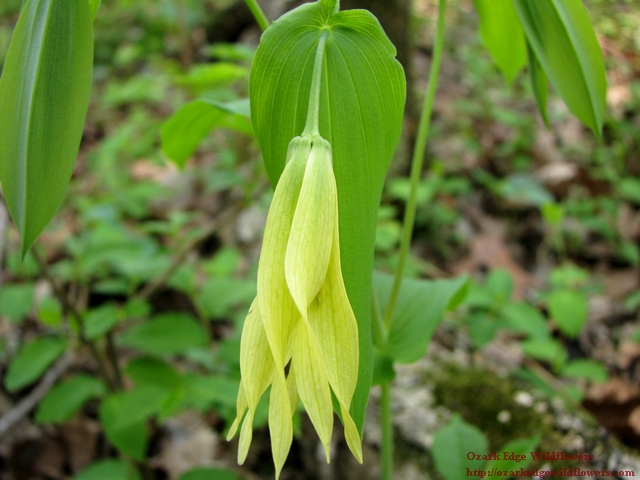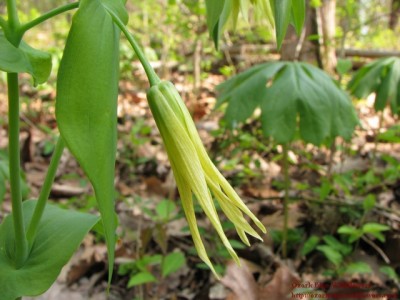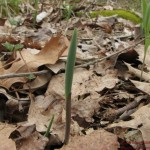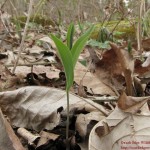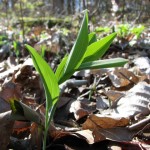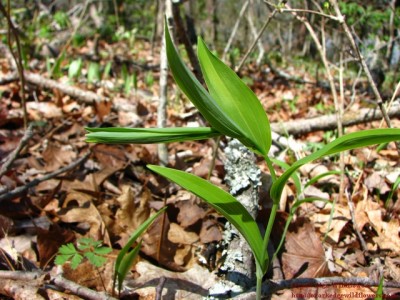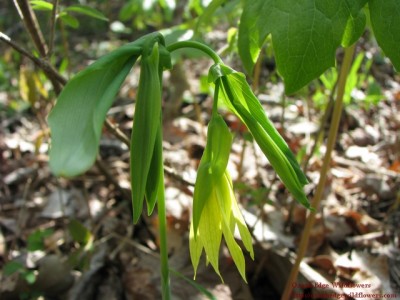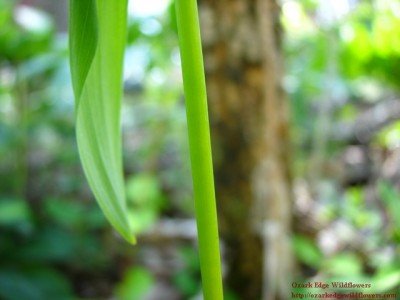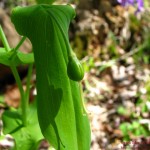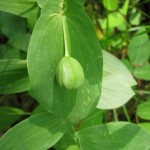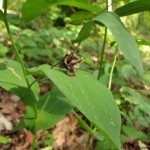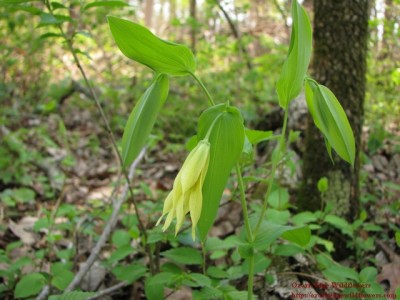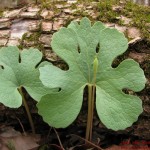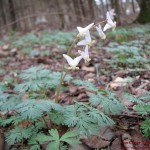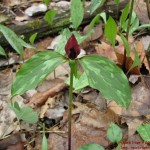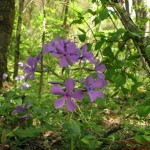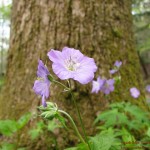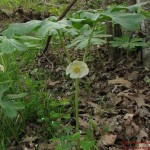Largeflower bellwort is a charming spring ephemeral. The interesting leaves look as if they have been sewn together by the stem and the plant always has a wilted look, no matter how much rainfall has occured. The single stem pierces a large leaf and then splits into twins. Only one twin can produce a flower-the other is always sterile. The bell-like bloom hangs down and sways in the slightest breeze and the yellow-green tepals are twisted like a girls hair that has previously been braided and finally let loose. The heavy seed pods hang like a pendant against the oval leaf. To me, it’s as interesting as the flower.
Latin Name/Common Name
Uvularia grandiflora is in the Liliacea family. It’s named for the latin word “uvula” which means “little grape”. Grandiflora is indicative of its large size compared to other members of the genus. There are 5 members of the genus in North America.
There are several common names. The most common is Largeflower (Large-flower, Large Flower) bellwort. But, a prettier common name is Merrybells or Big merrybells.
Bloom Color
The flowers of Uvularia grandiflora are a soft, buttery yellow.
Description
Uvularia grandiflora arises from a single, smooth stem in the early spring and reaches 1-2 ft when fully grown. The stem has a protective sheath at its base. Immature plants do not flower and remain single stemmed. In mature plants, the stem forks after piercing through a single large leaf. One branch is fertile, producing 1- 4 flowers and the other is sterile, without flowers. Both branches produce several oblong leaves with parallel veins. The light green leaves are perfoliate, meaning they completely encircle the stem. They are smooth on the surface and slighlty pubsecent below.
Despite spring temperatures and abundant rain, the leaves and flowers of Uvularia grandiflora typically have a wilted look. This is the normal appearance of the plant. The leaves are often slightly curled and the weight of the flower causes the stem to bend downward and the flower to hang—bell-like. The six flower tepals are twisted and sway with the slightest breeze.
Sheath surrounding new shoot and development of early leaves
Nodding stem from weight of flower bud
Drooping flower and unfurled leaves create a wilted appearance
Smooth, glaucous stem
Seed pod soon after flowering, near maturity and post maturity
Bloom Time
The blooming period for Uvularia grandiflora lasts several weeks on Ozarkedge. Depending on spring weather, the first blooms can be seen in late March or early April and extend to mid to late April. The pretty seed pods are found in late April to May. The foliage remains beautiful long after the flowers have faded.
Habitat
Rich woodlands with dappled sun are the preferred habitat of this delightful spring ephemeral.
What’s Growing Nearby?
Ozarkedge has many spring ephemerals growing alongside Uvularia grandiflora. Although the blooms have usually faded, the beautiful leaves of Bloodroot (Sanguinaria canadensis) are heavily populated in the same habitat. Dutchman’s breeches (Dicentra cucullaria) and Trillium recurvatum are frequently in peak bloom with Uvularia grandiflora. The blue and purple flowers of Phlox divaricata are sprinkled here and there and often caught at the edge of my photographs. Another woodland beauty in synchronous bloom is Geranium maculatum. The huge leaves of Mayapple (Podophyllum peltatum) are often seen towering over Uvularia grandiflora like giant umbrellas. Their blooms usually appear a week or two later. These are pictured below in order of their bloom time.
Sanguinaria canadensis Dicentral cucullaria Trillium recurvatum
Phlox divaricata Geranium maculatum Podophyllum peltatum
Endangered List
Uvularia grandiflora has lost much of its preferred habitat and is on the endangered list in Connecticut and New Hampshire. In Arkansas, it is found chiefly in the Ozark region, being absent from the southern portion of the state.
http://plants.usda.gov/java/profile?symbol=UVGR&photoID=uvgr_1h.jpg
Interesting Tidbits
Native Americans used this plant as a sedative and to treat snake bites. The young shoots are supposedly edible if boiled and prepared like asparagus. Its a bad idea to dig endangered plants for food, so I think I’ll stick to asparagus.
